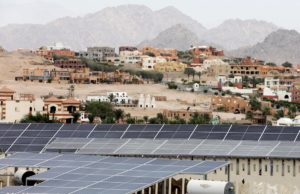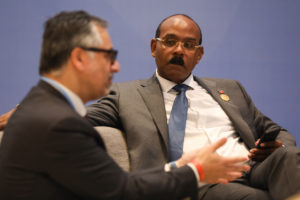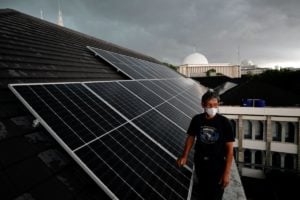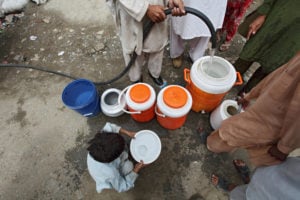Experts from the Intergovernmental Panel on Climate Change (IPCC) have distilled this year’s main findings from climate science, in the hope that government delegates will take them on board at the ongoing UN climate summit.
“The insights are alarming and tell us where urgent action is needed,” Simon Stiell, executive secretary of the UN Framework Convention on Climate Change (UNFCCC), said at the report’s launch during COP27 in Sharm El-Sheikh, Egypt.
“This report is a reaction of scientific frustration” at the lack of progress in climate negotiations, said Johan Rockström, a prominent IPCC author.
The first of the 10 insights is that “adaptation alone cannot keep up with the impacts of climate change”, Stiell said.
Aditi Mukherji, a water expert and an IPCC author, pointed out: “Adaptation measures will not remain very effective at higher levels of global warming.”
On “Questioning the myth of endless adaptation”, the report says:
- Limits to adaptation are being breached already in different places across the world. Climate adaptation will become increasingly difficult as we approach 1.5 degrees Celsius or 2C above pre-industrial temperatures.
- Existing adaptation efforts are falling short of adequately reducing risks from past, current and future climate change, leaving the most vulnerable particularly exposed to climate impacts.
- Adaptation cannot substitute for ambitious mitigation efforts. Even effective adaptation will not avoid all losses and damages, and new limits to adaptation can emerge in the shape of conflicts, pandemics and pre-existing development challenges.
- Deep and swift mitigation is critical to avoid widespread breaching of adaptation limits.
The second insight is that “vulnerability hotspots cluster in ‘regions at risk’”.
The experts say:
- Approximately 1.6 billion people live in vulnerability hotspots, a number projected to double by 2050. Climate-driven hazard mortality is 15 times higher in hotspot countries than in the least-vulnerable countries.
- Vulnerability – the susceptibility to be adversely affected by climate-driven hazards – is a product of structural inequality in human-environmental systems. It is clustered in major “regions at risk”: in parts of Central America, Asia and the Middle East, and in Africa across the Sahel, Central and East Africa.
- Communities in these regions at risk are increasingly exposed to climate change and climate-related hazards, where resilience (physical, ecological and socioeconomic) decreases with worsening levels of inequality, state fragility and poverty.
Need for attention to health and security, among other concerns
A major climate change impact that has the attention of experts but is still far from the negotiating rooms at Sharm El-Sheikh is on health. Rockström said that given the experience of the Covid-19 pandemic, “we need early warning systems for health impacts”.
Kristie Ebi, another IPCC author, put it far more strongly at the launch. “People are dying now, but half of 1% of UNFCCC funds go to health,” she pointed out. “Health systems are unprepared for shocks.”
The report’s third insight concerns “new threats on the horizon from climate-health interactions”:
- Compounding and cascading risks due to climate change are adversely impacting human, animal and environmental health.
- Climate change is already responsible for close to 40% of heat-related deaths and every inhabited continent is experiencing increased heat-related mortality.
- Wildfires are increasing in frequency due to the combination of higher temperatures and drought, bringing short- and long-term physical and mental health impacts.
- Outbreaks of infectious diseases are likely to increase due to climate change.
Then there is the big question of how much of human migration is being forced by climate change impacts. According to Rockström, the experts have calculated that 88.9% of displacement is now weather-related. This will intensify the debate on climate refugees.
The report’s key messages from its fourth insight are:
- Involuntary migration and displacement will increasingly occur due to climate change-related slow-onset impacts and the rising frequency and intensity of extreme weather events.
- Climate change and related impacts can also result in many people, particularly poor and marginalised communities, losing their capacity to adapt by moving away. However, others will choose to stay, despite facing increasing climate risks.
- Worldwide, there is a growing number of anticipatory humanitarian actions to assist climate-related mobility and minimise displacement – with early success stories
A related set of insights is that human security requires climate security. Rockström said: “Climate change is an amplifier of insecurity.”
The report says:
- Human security depends on climate action.
- Climate change does not cause conflict; rather, it exacerbates existing vulnerabilities in human security (caused by governance and socioeconomic conditions), which can lead to violent conflict.
- By increasing vulnerabilities and instability, the human security impacts of climate change become national security concerns.
- Effective and timely mitigation and adaptation strategies are required to strengthen human security and, by extension, national security. These must be pursued in parallel with concerted efforts to provide for human security to reduce the risks of increasing violent conflict and promote peace.
- The Russian invasion of Ukraine has revealed significant problems in terms of food supply and stable access to energy at local, national and international scales that arise from a dependence on fossil fuels. These vulnerabilities erode human security.
With 25% of the greenhouse gases warming the atmosphere absorbed by nature, sustainable land use is essential to meeting climate targets. The report says:
- Agricultural intensification that is long-term sustainable is preferable to further expansion into natural areas, when proper policies are in place to limit increased land conversion. Efforts to increase food production through enhanced yields and system integration while minimising adverse ecological impacts can likewise do much to further food security.
- Land uses that achieve an optimal bundle of services (for climate solutions, food security and ecosystem integrity alike) depend on the climate pathway – the higher the degree of warming, the less likely the current assumptions about the capacity of land systems to deliver these co-benefits will apply.
- Integrated land management can provide climate solutions while also benefiting people and the environment; however, land-use changes entail trade-offs more often than mutual wins. Approaches that work to balance trade-offs identified by stakeholders are more likely to provide socially acceptable climate and conservation outcomes.
The widest faultline at this and other recent UN climate summits has been over the question of finance from developed to developing countries. Developed countries have repeatedly said private finance for climate action is the only major option. But the IPCC experts have now concluded in their seventh insight that “private sustainable finance practices are failing to catalyse deep transitions”.
Rockström said the only way out was to “use the right price of carbon [emissions]”. “We can’t negotiate with the planet; there are physical limits,” he pointed out, and put the “social cost” at USD 200 per ton of emissions. Currently, the highest price is in the European Union carbon market, at EUR 73 per ton.
The report says:
- Financial markets are crucial for delivering net zero, especially in economic sectors with heavy climate impacts. However, private sector “sustainable finance” practices are not yet catalysing the profound and rapid transformations needed to meet climate targets.
- The large majority of today’s sustainable finance practices are designed to fit into the financial sector’s existing business models rather than to allocate capital in ways that would provide the most impact on combating climate change. The result is that a large share of sustainable finance practices to date do not have strong impacts for shifting capital; they are only moderate drivers of sustainability.
- Implementing and strengthening climate policy measures, such as carbon prices and taxes, minimum standards, and support measures for low-carbon solutions, remain most important for directing economic incentives towards climate solutions and thus shifting capital towards these solutions.
- Private sustainable finance practices must also advance rapidly so that they are better aligned with climate policy efforts and enhance those efforts. To this end, policymakers need to develop policies aimed directly at the financial sector that (a) significantly improve on the transparency of emissions embodied in investments and savings; and (b) ensure that capital flows become aligned with the Paris targets in ways that have real impacts on emissions and resilience in our economies.
And now, loss and damage
Conversations around climate change have moved from mitigating emissions, to adapting to its impacts, to the loss and damage taking place already. The new question at COP27 is whether or when a finance facility to deal with loss and damage will be activated.
Aditi Mukherji pointed out that “advances in attribution science help quantify loss and damage”. Attribution studies is a new discipline that measures the extent to which a disaster can be attributed to climate change.
Calling loss and damage an “urgent planetary imperative”, the report says:
- Losses and damages are already happening and will increase significantly on current (emission) trajectories, but rapid mitigation and effective adaptation can still prevent many of these.
- While many losses and damages can be calculated in monetary terms, there are also non-economic losses and damages that need to be better understood and accounted for,
- A coordinated, global policy response to losses and damages is urgently needed.
If the world is to effectively combat climate change and adapt to the impacts that are already here, “inclusive decision making is a must”, said Lisa Schipper, another IPCC author.
The report says:
- Climate-resilient development is built on societal choices that go beyond the formal decision-making of politicians and policymakers.
- Being inclusive and empowering in all forms of decision-making has been shown to lead to better and more just climate outcomes.
- Currently, the “inclusive” decision-making being done is insufficient to meet the needs of either action or justice.
If any of this is to be done, structural barriers have to be broken and unsustainable lock-ins must be stopped. Rockström called for a “move away from GDP” in national accounting.
- Mitigation strategies still remain insufficient to limit temperature increase to below 2C.
- Social progress measured by GDP growth and affluence is among the major drivers of GHG emissions, ingraining a resource-intensive economy that is a significant barrier to climate change mitigation.
- Vested interests within this political and economic system entrench unsustainable lock-ins – such as behavioural norms geared towards status consumption, business models focused on ever-increasing production, weak or vague climate policies, and even the use of outright violence that benefits fossil fuel industries – across social norms, industry and economy.
- Costs of climate change driven by a fossil fuel-based energy system are readily externalised onto communities deprived of the collective agency to resist.
- Interventions across all structural barriers simultaneously to remove unsustainable lock-ins are crucial if we are to achieve true transformational change.









